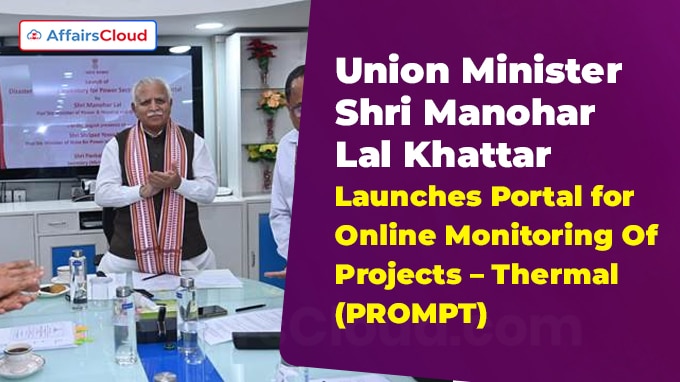 On 20th August 2024, Union Minister Manohar Lal Khattar, Ministry of Power, launched three online platforms : Portal for Online Monitoring of Projects – Thermal (PROMPT), Disaster Resilient Infrastructure for Power Sector (DRIPS) and Online Portal for Monitoring Survey and Investigation Activities of Hydro Electric Projects and Pumped Storage Projects (JAL VIDYUT DPR) to enhance the efficiency, transparency, and effectiveness of power sector.
On 20th August 2024, Union Minister Manohar Lal Khattar, Ministry of Power, launched three online platforms : Portal for Online Monitoring of Projects – Thermal (PROMPT), Disaster Resilient Infrastructure for Power Sector (DRIPS) and Online Portal for Monitoring Survey and Investigation Activities of Hydro Electric Projects and Pumped Storage Projects (JAL VIDYUT DPR) to enhance the efficiency, transparency, and effectiveness of power sector.
- He also launched a comprehensive Compendium of Central Electricity Authority (CEA) Regulations notified by the CEA under the Electricity Act, 2003.
Portal for Online Monitoring of Projects – Thermal (PROMPT):
i.PROMPT is a centralized platform for real-time tracking and analysis of thermal power projects.
ii.It enhances transparency, accountability, and resource optimization in project management.
iii.It aims to reduce time and cost overruns, ensuring efficient project execution and meeting electricity demand at reasonable prices.
Disaster Resilient Infrastructure for Power Sector (DRIPS):
i.The DRIPS portal enables swift identification and deployment of resources to address power sector disruptions during disasters like cyclones, earthquakes, and floods. Developed by CEA, it is aligned with India Disaster Resource Network (IDRN) and hosted on the National Power Portal, covering generation, transmission, and distribution.
ii.It connects designated nodal officers across power sector departments and agencies in affected areas, facilitating quick power restoration.
iii.DRIPS acts as a single point of contact for managing inventory of essential power system equipment and supplies, crucial for emergency response.
iv.Establishing this Disaster Resource Inventory is essential to protect lives, property, and critical services, thus enhancing the resilience and effectiveness of the power sector’s disaster response.
JAL VIDYUT DPR:
i.The Online Portal for Monitoring Survey and Investigation Activities of Hydro Electric Projects and Pumped Storage Projects (JAL VIDYUT DPR) is a key initiative by CEA to support the growth of hydropower and pumped storage projects (PSPs) in India.
- Notably, 11 hydroelectric projects with a combined capacity of 9 GW (Giga Watt) and 39 PSPs with 57 GW capacity are currently under survey and investigation.
ii.It plays a crucial role in enhancing grid stability and providing balancing power during energy transitions.
iii.The portal provides an overview of project development, improving management and coordination throughout the preparation of Detailed Project Reports (DPRs), reducing timelines for appraisals and approvals.
Compendium of CEA Regulations:
The compendium of CEA Regulations outlines regulations covering grid standards, technical requirements, safety measures, and more. It provides a robust framework for the generation, transmission, distribution, and trading of electricity nationwide.
Key Points:
i.It establishes guidelines for grid operation and maintenance, including standards for voltage, frequency, and system security, and the integration of diverse energy sources.
ii.Technical requirements are set for connecting generating stations, including renewable sources, to the grid, ensuring stability and smooth integration.
iii.The compendium also includes safety standards for the construction, operation, and maintenance of electrical plants and lines, including recent amendments for safety audits and early warning systems in hydro projects.
iv.It ensures flexible operation of coal-based thermal power plants, with a minimum power level of 40%, supporting the grid as renewable energy use increases.
Metering practices are standardized to ensure accurate billing, reliability, and transparency in the electricity sector.
v.Data submission related to electricity generation, transmission, and distribution is mandated to enable the CEA to monitor and analyze the power sector’s performance.
vi.Communication system standards are established to enhance the operational efficiency of the power grid through improved data transfer and real-time monitoring.
Specifications for designing, constructing, and maintaining electrical plants and lines are outlined, ensuring safety, reliability, and efficiency.
Recent Related News:
i.Tata Power Solar Systems Limited(TPSSL) has launched ‘Ghar Ghar Solar, Tata Power ke Sang’ initiative in Varanasi to promote residential Rooftop Solar Solutions (RTS) across Uttar Pradesh (UP).
ii.The Asian Development Bank (ADB) has signed a long-term local currency loan agreement with France-based ENGIE Group, to construct and operate a 400 MegaWatt (MW) solar photovoltaic power plant in Surendranagar district in Gujarat, India.
About Central Electricity Authority (CEA):
It was established as a part-time body in 1951 and became a full-time body in 1975. The functions and duties of CEA are delineated under Section 73 of the Electricity Act, 2003.
Chairperson– Ghanshyam Prasad
Headquarters– New Delhi, Delhi




